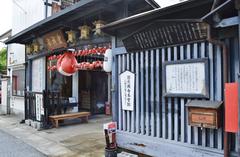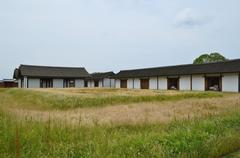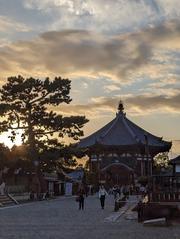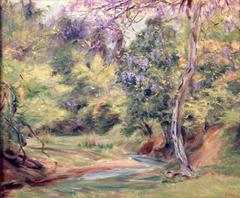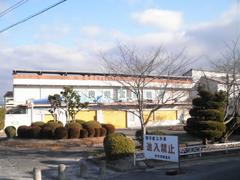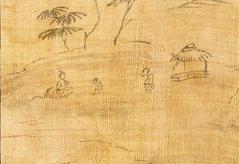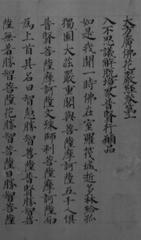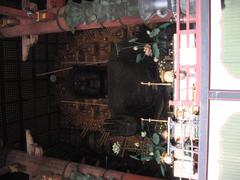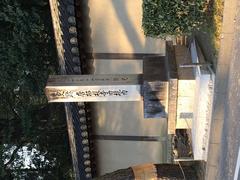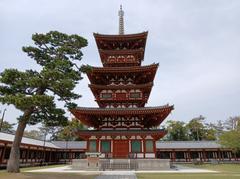
Kasuga-Taisha Visiting Hours, Tickets, and Guide to Nara Historical Sites
Date: 14/06/2025
Introduction
Kasuga-Taisha Shrine, nestled in the heart of Nara, Japan, is a celebrated Shinto sanctuary recognized for its vibrant architectural style, lush primeval surroundings, and deep historical significance. Founded in 768 CE by the influential Fujiwara clan, Kasuga-Taisha has served as both a spiritual guardian of the ancient capital and a hub of Japanese culture, ritual, and artistry. The shrine is especially famed for its thousands of stone and bronze lanterns, the biannual Mantoro Lantern Festivals, and the sacred sika deer that roam freely in the adjacent Nara Park. Whether you are drawn by its heritage, natural beauty, or living traditions, Kasuga-Taisha offers an immersive window into Japan’s spiritual and cultural legacy (Japan Documented; bochi-bochi-japanese-dailylife.com; Japan Experience).
This comprehensive guide details Kasuga-Taisha’s history, unique features, visiting hours, ticketing, accessibility, nearby attractions, and essential tips to help you plan a rewarding visit.
Table of Contents
- Historical Overview
- Visiting Kasuga-Taisha: Practical Information
- Seasonal Highlights and Photography Tips
- Visitor Etiquette
- Frequently Asked Questions (FAQ)
- Conclusion and Call to Action
- References
Historical Overview
Foundations and Early History
Kasuga-Taisha was established in 768 CE by the Fujiwara clan, one of the most powerful aristocratic families in Japanese history. As Nara was then the imperial capital, the shrine played a protective role over the city and its rulers. Four deities—Takemikazuchi-no-mikoto, Futsunushi-no-mikoto, Amenokoyane-no-mikoto, and Himegami—are enshrined here, each safeguarding different aspects of the nation and the Fujiwara lineage (Japan Documented; Japan Travel Explorer).
The Fujiwara Clan and Imperial Ties
Kasuga-Taisha served as the tutelary shrine for the Fujiwara, shaping court rituals and exerting religious and political influence throughout the Heian period (794–1185). Festivals such as the Kasuga Matsuri, originating in this era, continue to honor both the shrine’s deities and its aristocratic heritage (Intrepid Scout).
Architectural Evolution and Rituals
The shrine is the archetype of the kasuga-zukuri architectural style—marked by vermilion pillars, white walls, and cypress bark roofs (Japan Experience). Structures such as the main sanctuary, Rōmon gate, and long lantern-lined corridors are designated as Important Cultural Properties. A distinctive tradition at Kasuga-Taisha is the Shikinen Zōtai, the ritual rebuilding of shrine structures every 20 years, preserving spiritual purity and architectural continuity. The most recent restoration was completed in 2016 (Japan Documented).
Sacred Landscape and Primeval Forest
Surrounding the shrine is the Kasugayama Primeval Forest, a 250-hectare ancient woodland protected since 841 CE and now a UNESCO World Heritage Site. The forest is home to hundreds of plant and animal species, and its untouched state embodies Shinto’s reverence for nature (Nara Park; annees-de-pelerinage.com). Visitors approach the shrine through paths lined with over 2,000 stone lanterns and 1,000 bronze lanterns, many featuring deer motifs.
The Sacred Deer and Mythology
Kasuga-Taisha is famed for the sacred sika deer that roam freely in Nara Park. Legend says the deity Takemikazuchi-no-mikoto arrived in Nara riding a white deer, establishing the animal as a divine messenger—an identity still embraced and protected today (umamibites.com; bochi-bochi-japanese-dailylife.com).
UNESCO Status and Cultural Legacy
In 1998, Kasuga-Taisha and the Kasugayama Forest were inscribed as part of the UNESCO “Historic Monuments of Ancient Nara” World Heritage Site, recognizing their outstanding value as living repositories of Japanese religious and cultural tradition (lestacworld.com).
Visiting Kasuga-Taisha: Practical Information
Visiting Hours and Admission
-
Main Sanctuary General Worship
- March–October: 6:30–17:30
- November–February: 7:00–17:00
-
Special Worship of Main Sanctuary
- 9:00–16:00
- Closed: March 8–13, December 20–January 7, and the second Monday of January (Kasuga-Taisha Official)
-
Kasugataisha Museum
- 9:00–16:30 (last admission at 16:00)
- Closed Tuesdays (June–March, except holidays); open daily April–May
-
Manyou Botanical Garden
- 9:00–16:30 (last admission at 16:00)
- Closed Tuesdays (June–March, except holidays); open daily April–May
Admission Fees:
- Special Worship of Main Sanctuary: ¥700 (free for junior high and under)
- Kasugataisha Museum: Adults ¥700, University/High School ¥400, Junior High/Elementary ¥300
- Manyou Botanical Garden: Adults ¥700, Children ¥300
- Shrine Seal (Goshuin): ¥500
- General shrine grounds: Free
How to Get There
-
By Train:
- From Kyoto: JR Nara Line to JR Nara Station (45 min), or Kintetsu Limited Express to Kintetsu-Nara Station (35 min)
- From Osaka: JR Yamatoji Line (about 1 hr) or Kintetsu Nara Rapid Express (45 min)
-
By Bus:
- From either station, take a bus to “Kasuga Taisha Honden” (3 min walk to the main sanctuary)
- The City Loop Bus stops at “Kasugataisha Omotesando” (10 min walk)
-
By Car:
- 4.3 km from Nara city center; parking available for 100 cars (fees apply)
-
On Foot:
- 25-minute walk from Kintetsu-Nara Station through Nara Park (Thrillophilia)
Accessibility
- Most main paths are stroller- and pram-friendly; pets are allowed on leashes.
- Some areas have steps or gravel, which may be challenging for wheelchair users; staff assistance is available (Trip to Japan).
- Restrooms, souvenir shops, and refreshment stands are located near the entrance and in Nara Park.
Nearby Attractions
- Todai-ji Temple: Home to the Great Buddha
- Kofuku-ji Temple: Historic pagodas and halls
- Nara National Museum: Buddhist art and cultural treasures
- Man’yo Botanical Garden: Seasonal flowers and plants from ancient poetry (Japan Experience)
Guided Tours and Special Experiences
- Private and group tours are available in multiple languages; advanced booking is recommended during festivals (Trip to Japan).
- Special events include the Mantoro Lantern Festivals (February and August), Kasuga Matsuri (March), and Wakamiya On-Matsuri (December).
Seasonal Highlights and Photography Tips
- Spring (March–May): Cherry blossoms and wisteria blooms frame the shrine and approach pathways (TravelSetu).
- Autumn (November–December): Vibrant foliage provides spectacular views; autumn lantern festivals add an enchanting glow.
- Best Time of Day: Early morning for tranquility and photography; Mantoro Festivals for lantern-lit vistas (Matcha-JP).
Visitor Etiquette
- Purification: Wash hands and rinse mouth at the temizuya before entering the shrine.
- Photography: Permitted in most precincts, but restricted in designated sacred areas—always observe signage (Kasuga-Taisha Official).
- Deer: Feed only designated deer crackers (“shika senbei”); approach calmly and treat the animals respectfully (umamibites.com).
- Dress: Modest clothing is recommended when entering shrine buildings or attending rituals.
Frequently Asked Questions (FAQ)
Q1: What are Kasuga-Taisha’s visiting hours?
A1: 6:30–17:30 (March–October), 7:00–17:00 (November–February). Special Worship area: 9:00–16:00.
Q2: How much are tickets?
A2: Main grounds are free. Special Worship, Museum, and Botanical Garden: ¥700 each for adults.
Q3: Is the shrine wheelchair accessible?
A3: Most major paths are accessible, but some areas have steps or gravel. Staff assistance is available.
Q4: When are the lantern festivals?
A4: Mantoro Lantern Festivals occur in early February (Setsubun) and mid-August (Obon).
Q5: Can I feed or touch the deer?
A5: Feeding is allowed with purchased deer crackers. Deer are generally friendly but can be assertive.
Q6: How do I get to Kasuga-Taisha from Nara Station?
A6: 20–25-minute walk or short bus ride from either JR Nara or Kintetsu-Nara stations.
Conclusion and Call to Action
Kasuga-Taisha Shrine is a captivating fusion of spiritual tradition, architectural mastery, and natural beauty. Its lantern-lit paths, sacred deer, and vibrant seasonal landscapes create an unforgettable atmosphere that embodies the essence of Nara’s heritage. By planning your visit with the latest information on hours, tickets, and etiquette, you can fully immerse yourself in this iconic Japanese landmark.
Enhance your journey by exploring nearby historical sites, joining special festivals, and capturing the shrine’s timeless scenery. For updated travel tips, festival details, and interactive tools, download the Audiala app, explore our related articles, and follow us on social media.
Alt text: Kasuga-Taisha Shrine stone and bronze lanterns illuminated during sunset
Alt text: Map highlighting Kasuga-Taisha Shrine within Nara Park and nearby attractions
References
- Kasuga-Taisha Shrine in Nara: Visiting Hours, Tickets, History & Travel Tips (Japan Documented)
- Kasuga-Taisha Shrine: Visiting Hours, Tickets, and Exploring Nara’s Historic Gem (bochi-bochi-japanese-dailylife.com)
- Kasuga-Taisha Shrine: Visiting Hours, Tickets, and Exploring Nara’s Historic Landmark (Japan Experience)
- Kasuga-Taisha Shrine: Visiting Hours, Tickets, and Guide to Nara’s Historic Treasure (Espunis in Japan)
- Kasuga-Taisha Shrine and Kasugayama Forest (Nara Park Official)
- Kasuga-Taisha Shrine (annees-de-pelerinage.com)
- Kasuga-Taisha Shrine: Important to Know (lestacworld.com)
- What Makes Nara Deer Sacred (umamibites.com)
- Kasuga-Taisha Shrine Lanterns and Festivals (Matcha-JP)



